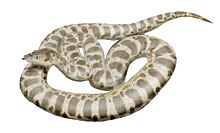Titanoboa
|
Titanoboa Temporal range: Paleocene, 60–58 Ma |
|
|---|---|
 |
|
| Illustration by Nobu Tamura | |
| Scientific classification | |
| Kingdom: | Animalia |
| Phylum: | Chordata |
| Class: | Reptilia |
| Order: | Squamata |
| Suborder: | Serpentes |
| Family: | Boidae |
| Genus: |
†Titanoboa Head et al., 2009 |
| Species: | †T. cerrejonensis |
| Binomial name | |
|
Titanoboa cerrejonensis Head et al., 2009 |
|
Titanoboa, /tiˌtɑːnoʊˈboʊə/; meaning " boa," is an extinct genus of snakes that is known to have lived in present-day La Guajira in northern Colombia. Fossils of Titanoboa have been found in the Cerrejón Formation, and date to around 58 to 60 million years ago. The giant snake lived during the Middle to Late Paleocene epoch, a 10-million-year period immediately following the Cretaceous-Paleogene extinction event. The only known species is Titanoboa cerrejonensis, the largest snake ever discovered, which supplanted the previous record holder, Gigantophis.
While initially thought to have been an apex predator of the Paleocene ecosystem in which it lived, evidence has pointed to the genus being dominantly piscivorous; a trait unique to Titanoboa among all boids. The size of T. cerrejonensis has also provided clues as to the earth's climate during its existence; because snakes are ectothermic, the discovery implies that the tropics, the creature's habitat, must have been warmer than previously thought, averaging about 32 °C (90 °F). The warmer climate of the Earth during the time of T. cerrejonensis allowed cold-blooded snakes to attain much larger sizes than modern snakes. Today, larger ectothermic animals are found in the tropics, where it is hottest, and smaller ones are found farther from the equator.
...
Wikipedia
